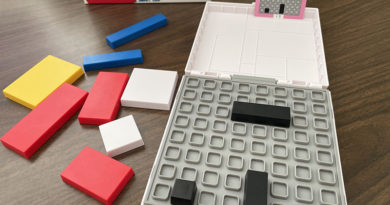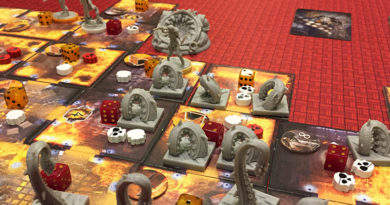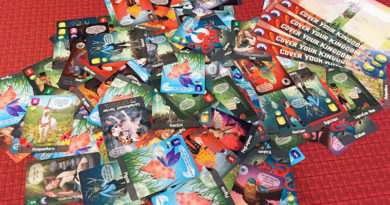Queenz Board Game Review
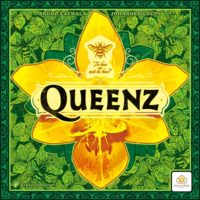
I’ve never been someone who loves bees.
I still have vivid memories of being stung by a bee when I was little and swelling up like crazy. So it’s hard for me to understand the desire of some people to become beekeepers.
It’s a good thing I don’t have to like bees to enjoy Queenz by Rio Grande Games.
It’s a fun set-collection and tile-laying board game where the players are beekeepers planting orchids to attract bees and produce the tastiest honey.
And it’s a great addition to a family board game collection.
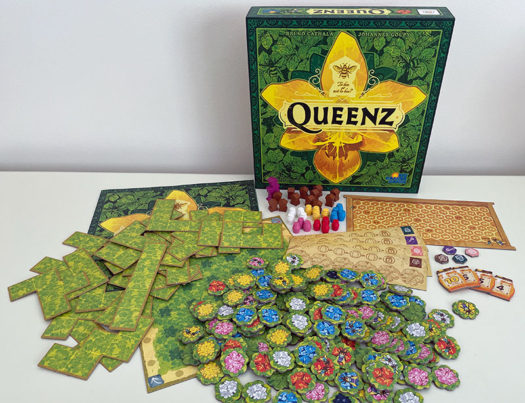
How to play Queenz
The goal in Queenz is to get the most points from planting orchids in your fields and attracting bees around your beehives.
Players take turns collecting flowers from the central board, adding them to their personal supply, and then planting them on their chosen fields. Players will earn points along the way as they plant contiguous colored flowers in their fields and will earn points at the end of the game from bees near their beehives.
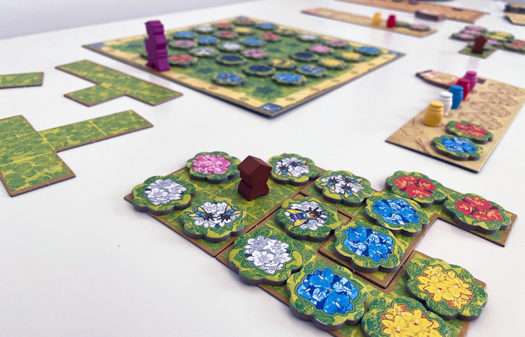
To set up the game, players randomly fill the central board with orchids and flip them face up. All of the Field tiles are shuffled to create a draw pile and 5 are drawn and placed next to the board. The honey pot bonus tokens are stacked in descending value and placed next to the score board. Each player takes a supply board, 3 Hives and 5 Honey pots (one of each color) and they’re ready to go.
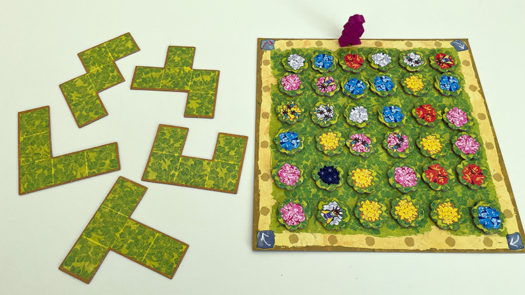
The person sitting to the right of the starting player chooses on which space to place the Gardener around the board.
On a player’s turn, they chose to do 1 of the following options:
- Take Orchid Tokens
- Fill One Field
Option 1: Taking Orchids
A player may take 1, 2, or 3 Orchids from the row or column where the Gardener is standing.
- If they only take 1 Orchid it may be any token.
- If they choose to take 2 Orchids, they may not include bees and may be of either the same or different colors.
- If they choose to take 3 Orchids, they may not include bees and must all be different colors.
The player then moves the Gardener clockwise around the board a number of spaces equal to the number of Orchid tokens they took.
Once taken, the player places the Orchid tokens on flower spaces on their personal supply board. If they don’t have any open spaces on their supply board, they can’t take this action.
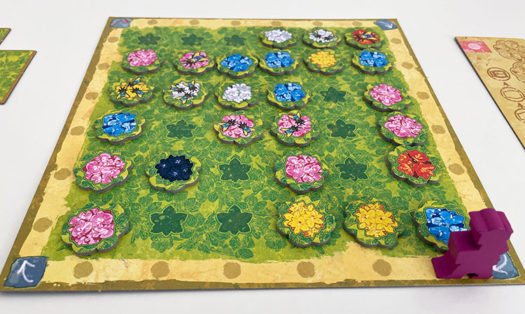
Option 2: Filling a Field
A player first chooses 1 of the available Field tiles from next to the board and places it in their area. If they already have some fields, the new field must be placed adjacent to their existing fields.
The player then fills every space on the placed Field tile with either Orchid tokens from their supply or Hives.
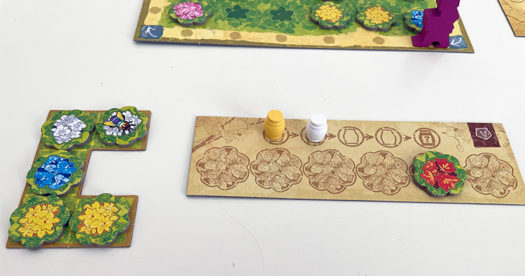
If the player just created or enlarged an area containing at least 2 Orchids of the same color, they immediately score points. The player scores 1 point for each Orchid of that area (contiguous color group).
For example, if the player placed 3 blue Orchids adjacent to each other, they would score 3 points for the blue Orchids. Likewise, on a later turn, if they place 2 blue Orchids on a new field so that they expand this contiguous area, they would score 5 points.
If it’s the first time a player creates a group of a certain color, they add that colored honey pot to their supply board. As soon as a player places their 5th honey pot, they take the top honey pot token from the stack.
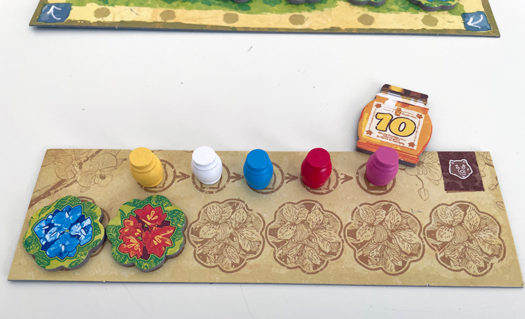
Queen Bees
Orchid tokens with a single bee are special tokens — they’re Queen bees.
When a player takes an Orchid with a Queen, they place it in their supply and may immediately choose to swap it with any other Orchid token from their Fields. When swapping this way, no points are earned.
This is an optional action and if the player chooses not to use it, they simply place the token in their supply.
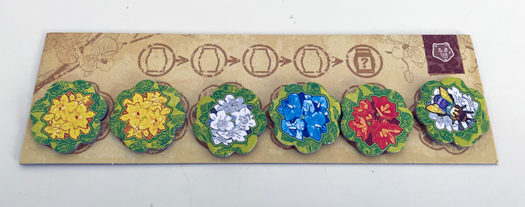
Refreshing the Board and Fields
Tokens taken from the board and Fields taken from those available do not get replaced immediately.
If the Gardener stops in front an empty row or column, the player that moved the Gardener gets 1 point and that row is immediately filled with Orchid tokens from the draw piles.
If a player takes the last of the 5 available Fields, they also score 1 point. Then 5 new Fields are drawn and placed next to the central board.
When the Gardener passes the corner of the board with the Red Arrow space, the player that moved the Gardener gets 1 point and everything is refilled. All open flower spaces on the central board are filled with newly drawn Orchid tokens and Field tiles are drawn to get back to 5 available Fields.
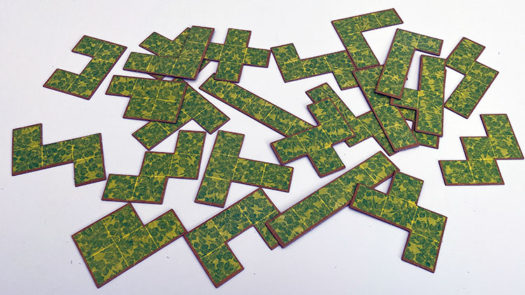
Game End
After a player plants their 5th Field, each other player takes a final turn.
On that final turn, players may either take new Orchid tokens or fill a field as usual. However, on that last turn, players may leave empty spaces on their new Field if they’re short of tokens or Hives.
Players score points as usual when planting Orchids on their final turn.
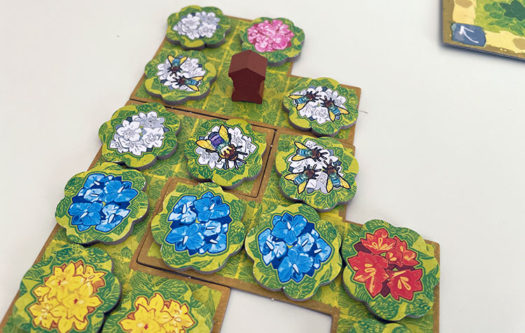
After all players have taken their final turn, players score points from their Hives. Each Hive scores 1 points for each bee on the 8 spaces surrounding it.
Players also add in their bonus points from the Honey Pot token they claimed during the game.
The player with the most points wins!
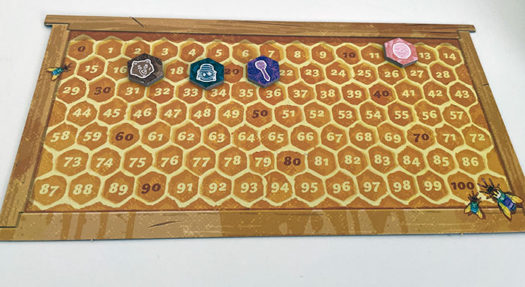
Can the whole family enjoy Queenz?
Everyone in the family can enjoy moving the gardener around the board and collecting orchids for their garden. And from that standpoint, it’s a pretty straightforward and easy game for everyone to play.
And we also think the recommended age of 8+ is pretty accurate.
That’s because below the surface can lie more strategy than you might originally think. As such, while younger kids might enjoy orchid collecting, they may miss the nuances about getting high scores.
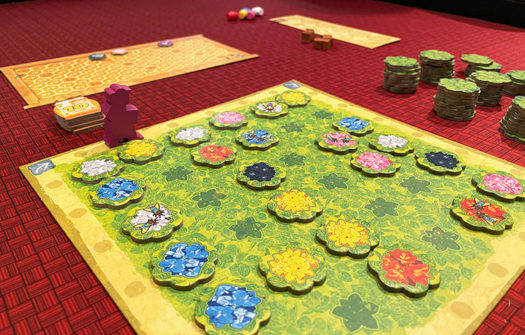
One of the things we look for in a good family board game is a nice balance of luck and strategy. And Queenz has a good balance.
The distribution of the orchids on the central board and which 5 Field tiles are available is all based on the luck of the draw.
But there’s a nice amount of strategy in choosing which orchids to collect and which shaped Field tiles to take. There’s also strategy on when and where to place your hives along the way for end-game scoring.
We find it interesting that the Field tiles all have 5 spaces yet a player’s board has 6 spaces for orchids. Which means that while you can fill up your player board with orchids before you claim a Field tile, you won’t be able to plant them all.
It’s a nice element to keep players thinking about which and how many orchids to gather before planting fields.
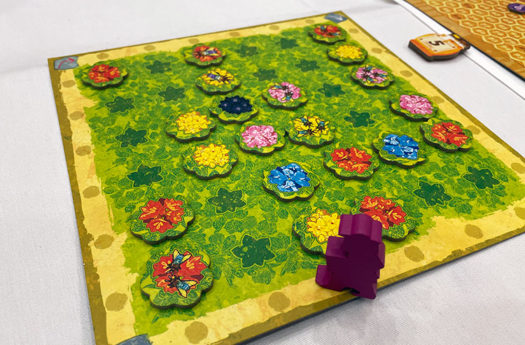
Then there’s the factor of what your opponents are doing.
While players can’t directly mess with another player’s fields, they can limit the options for other players based on their choices. When considering which orchids to take, astute players will also pay attention to how many spaces it will move the gardener and thus may limit the next player’s options.
Because of the honeypot bonuses, there’s also a race to see who will claim the top 10-point bonus token by having diversified production.
Yet, that may also come at a cost. Because if you’re gathering the whole variety of colors, you may not be scoring a ton along the way by expanding big areas of a single color.
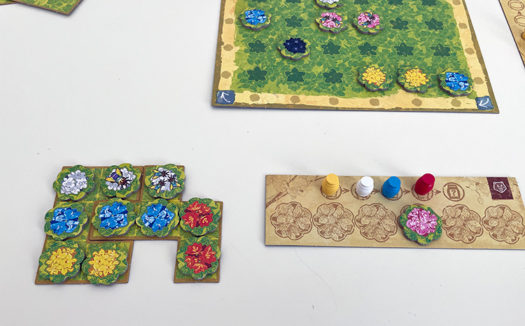
Plus, the game ends when one player plants their 5th field, so players should also keep an eye out for when the game is reaching the end and make their play for the most points they can.
And let’s not forget the bees!
Players must also factor in collecting orchids with bees on them to score points at the end of the game. Sure when collecting an orchid with bees on it from the central board means you can only take 1 orchid that turn, depending on where you plant it, it may score many points in the end. So players shouldn’t always just collect more orchids. It can pay to take just a single orchid with bees.
So you see, there are plenty of choices to consider during a game of Queenz to keep your strategic thinking sharp. Yet at the same time, they’re light enough to fit great with family game play.
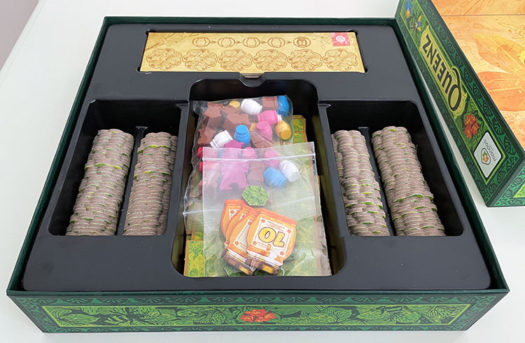
How does Queenz score on our “Let’s Play Again” game meter?
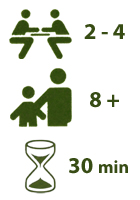 Queenz scores very well on our “let’s play again” game meter because of the fun game play and balance between luck and strategy. It has simple to understand rules that make it easy to teach new players and the game time comes in around 30 minutes. So it’s also easy to play a couple of games back to back.
Queenz scores very well on our “let’s play again” game meter because of the fun game play and balance between luck and strategy. It has simple to understand rules that make it easy to teach new players and the game time comes in around 30 minutes. So it’s also easy to play a couple of games back to back.
The game insert has fitted spaces to keep all the components organized no matter how you store it on your game shelves. But we also wish it came with a draw bag for the orchid tiles rather than needing to stack them. It would help the set up and take down be a bit simpler with such a bag.
Overall, a big thumbs up for Queenz.
We’d like to thank Rio Grande Games for a review copy of Queenz.



